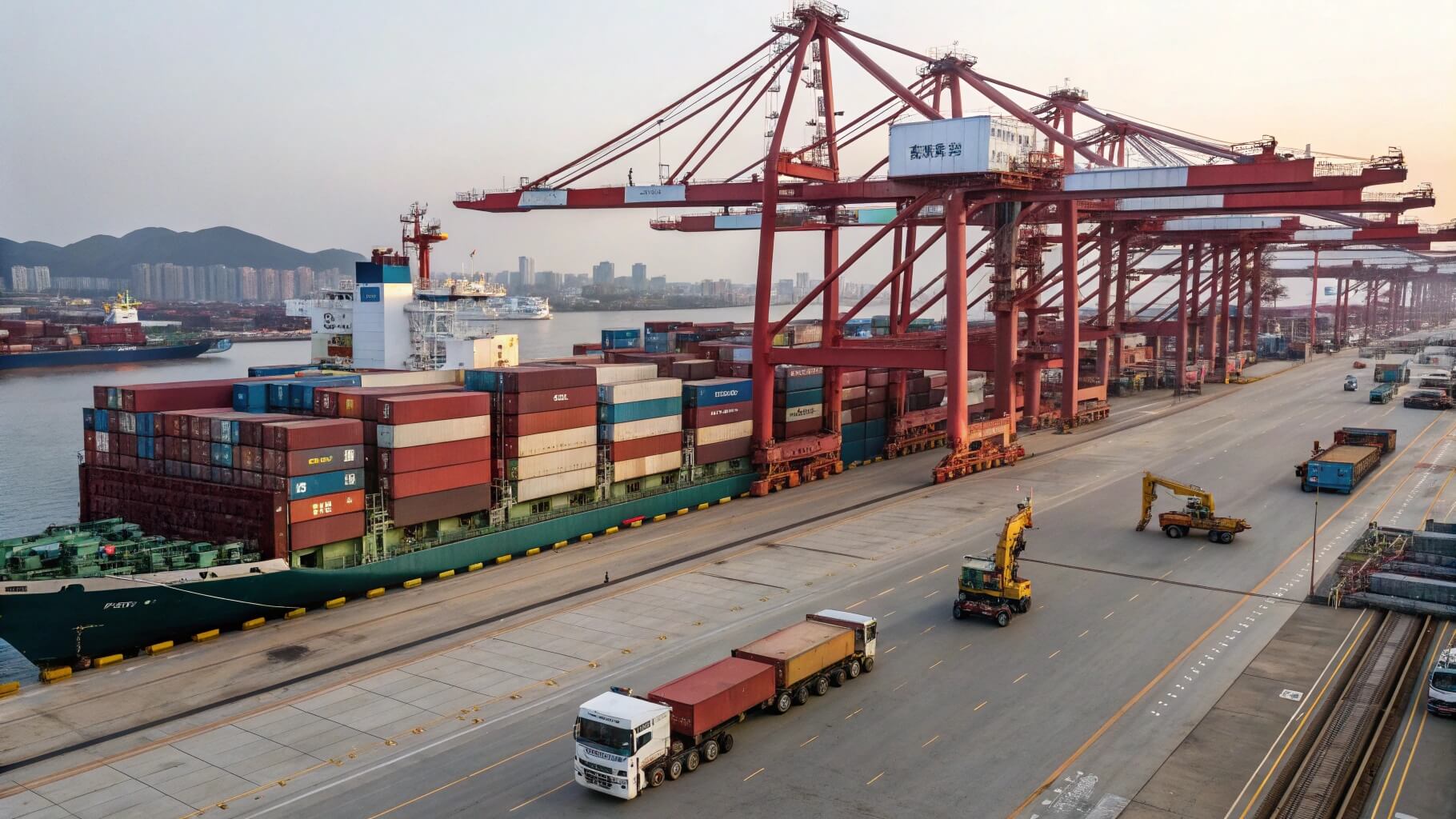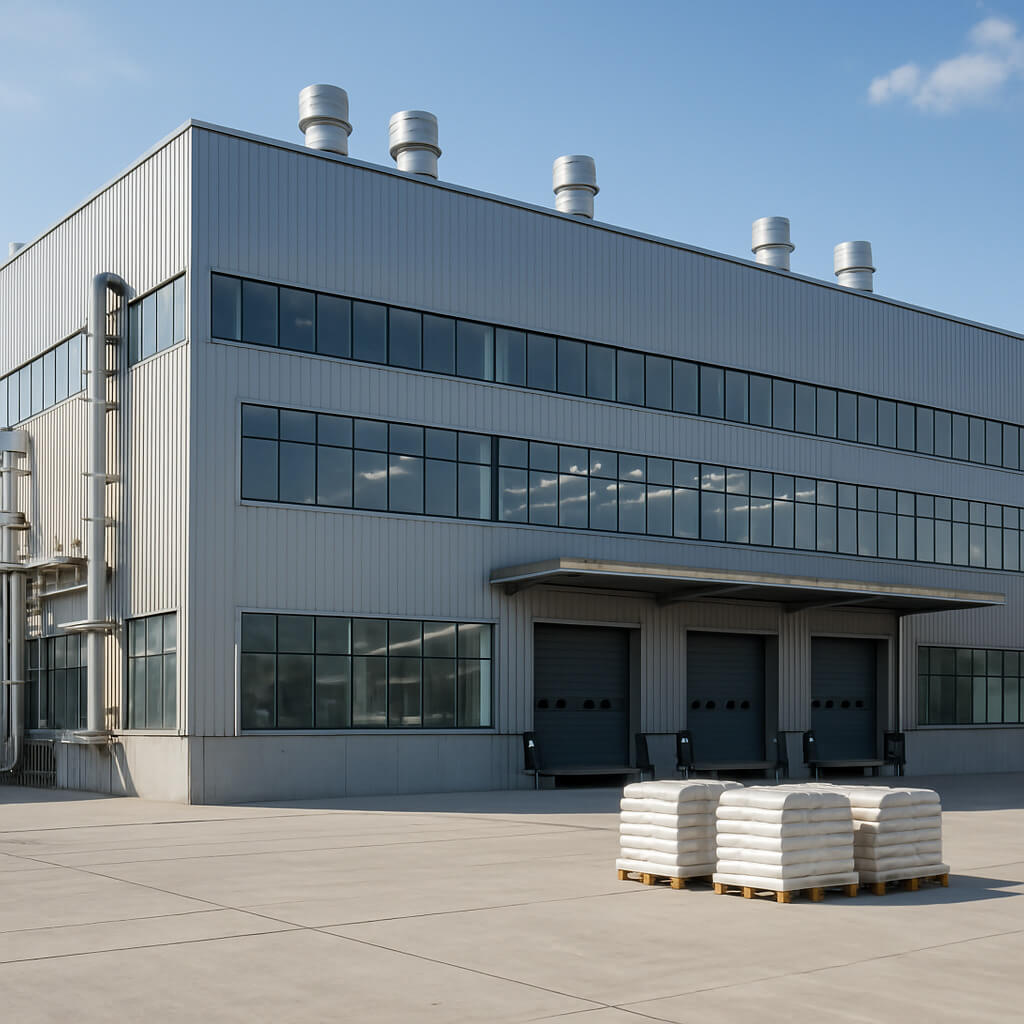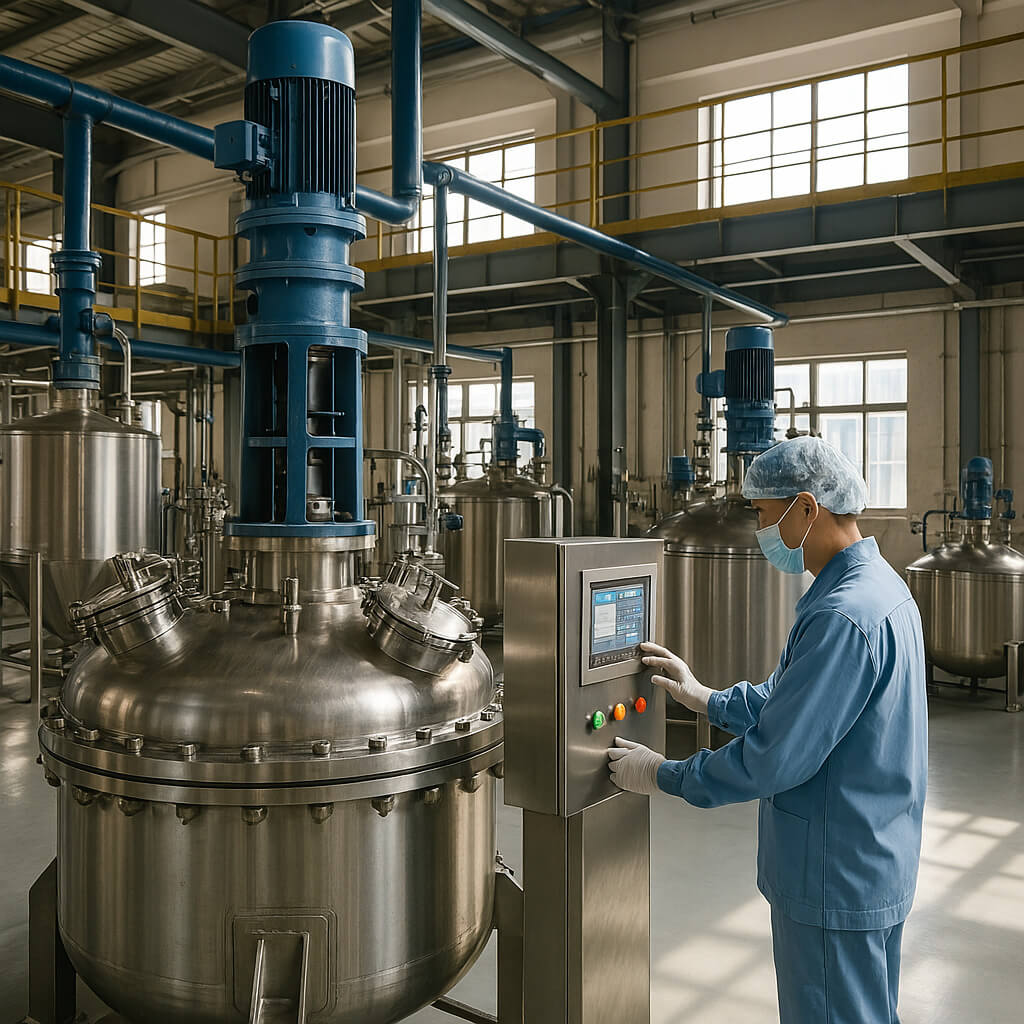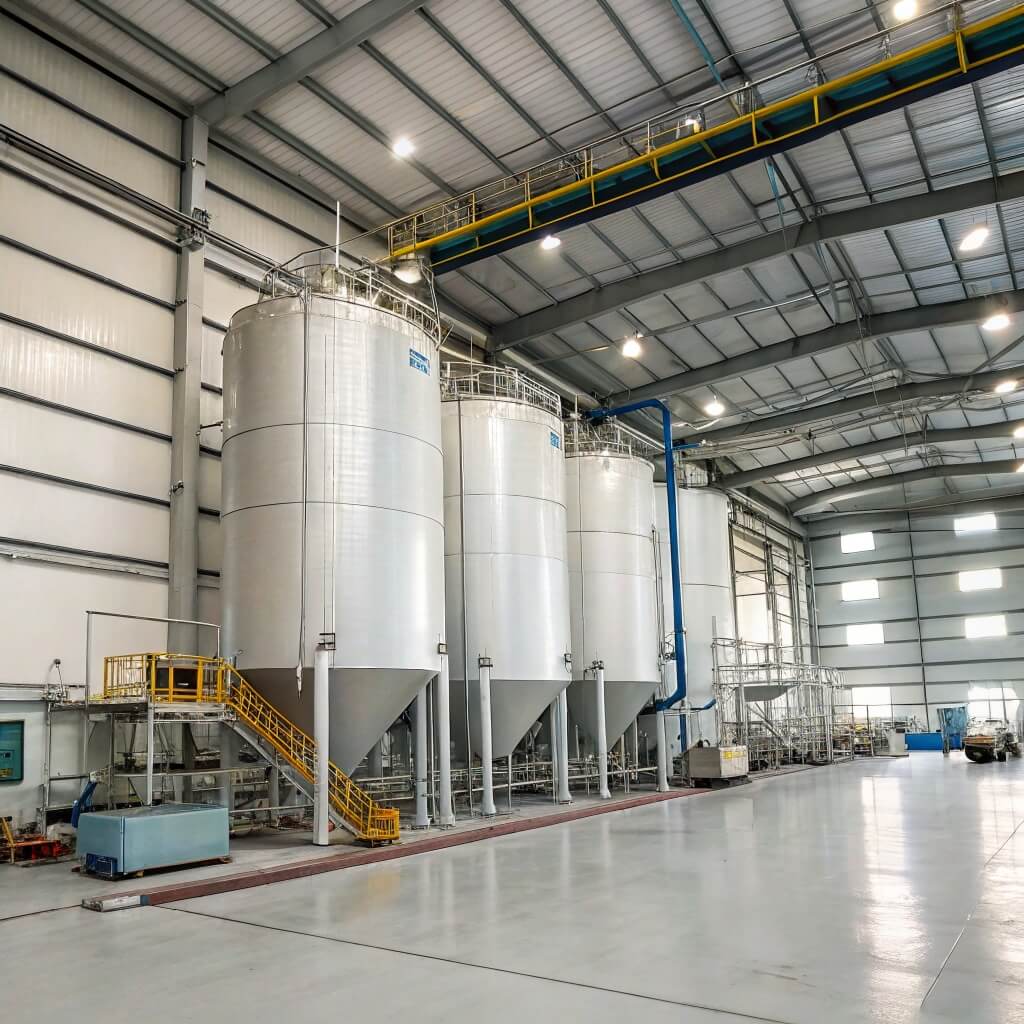Finding reliable HPMC supply can make or break your production schedule. When sourcing from China, how long must you wait before that crucial shipment arrives at your facility?
The lead time for HPMC exports from China typically ranges from 45-90 days, encompassing production (15-30 days), quality testing (3-7 days), documentation (5-10 days), and shipping (20-45 days depending on destination).

A busy Chinese port showing the logistics operations involved in HPMC exports, with containers being loaded for international shipping to global destinations.
Understanding the complete export timeline helps procurement managers set realistic expectations and plan inventory effectively. Let's break down each stage of the HPMC export process from China.
What are the typical stages involved in the HPMC export timeline?
Production planning requires accurate timelines. What key phases should you anticipate when importing HPMC from China?
The HPMC export process from China follows a structured sequence of stages, each with its own timeline and potential variables. Understanding these stages helps buyers plan effectively and identify where delays might occur.
The process typically begins with order confirmation and production scheduling, requiring 3-5 business days to confirm specifications, allocate production capacity, and schedule manufacturing slots. Raw material preparation follows, taking 5-7 days for standard grades. The China Chemical Industry Association maintains standards for raw material quality that reputable manufacturers follow.
The manufacturing process itself typically requires 10-20 days depending on grade complexity and batch size. This includes reaction time (2-3 days), washing and purification (3-5 days), drying (2-4 days), and milling to achieve target particle size distribution (1-2 days).
Quality control testing adds 3-7 days to the timeline. Comprehensive testing includes viscosity measurement, substitution degree verification, moisture content analysis, and application-specific performance testing. The United States Pharmacopeia provides standardized testing methods that many Chinese manufacturers now follow.
Packaging and preparation for shipment requires 2-4 days, including moisture-resistant packaging, palletization, container loading, and preparation of shipping documents. Documentation and export clearance typically takes 5-10 days, encompassing preparation of commercial invoices, packing lists, certificates of analysis, certificates of origin, and export declarations.
Transit time varies significantly based on destination and shipping method, ranging from 20-45 days for sea freight to major global markets. Air freight can reduce this to 3-7 days but at substantially higher cost.
| Export Stage | Typical Duration | Key Variables |
|---|---|---|
| Order Confirmation | 3-5 days | Specification complexity, technical review requirements |
| Rohstoffaufbereitung | 5-7 days | Standard vs. specialized grades, supplier availability |
| Manufacturing Process | 10-20 days | Grade complexity, batch size, viscosity level |
| Qualitätskontrolltests | 3-7 days | Standard vs. pharmaceutical grade, testing complexity |
| Packaging & Preparation | 2-4 days | Packaging requirements, container loading efficiency |
| Documentation & Clearance | 5-10 days | Export license requirements, customs efficiency |
| Transit Time | 20-45 days | Destination, shipping method, port congestion |
How long does it take to manufacture and package HPMC in China?
Production capacity concerns many buyers. What manufacturing timeframes should you expect from Chinese HPMC producers?
The manufacturing and packaging timeline for HPMC in China typically ranges from 15-30 days, depending on several factors including product specifications, order volume, and manufacturer capabilities.
The production process begins with raw material preparation, which takes 5-7 days for standard grades. This includes sourcing and quality testing of cellulose raw materials, typically derived from cotton linters or wood pulp. The International Organization for Standardization provides guidelines for raw material quality management that reputable manufacturers follow.
The core manufacturing process requires 10-20 days, with several distinct phases. The reaction phase, where cellulose undergoes etherification with propylene oxide and methyl chloride, typically takes 2-3 days. This is followed by neutralization and washing processes (3-5 days), drying phase (2-4 days), and milling operations (1-2 days).
Quality control testing adds 3-7 days to the manufacturing timeline. Standard grades undergo basic testing including viscosity, substitution degree, moisture content, and particle size distribution. Pharmaceutical and food grades require additional testing for microbiological limits, heavy metals, and residual solvents.
Manufacturing capacity utilization significantly impacts production timelines. During peak demand periods (typically preceding construction season in major markets), production slots may be limited, potentially extending lead times by 5-10 days.
| Manufacturing Stage | Standard Duration | Key Variables |
|---|---|---|
| Rohstoffaufbereitung | 5-7 days | Specialized grade requirements, supplier delays |
| Reaction Phase | 2-3 days | High substitution degree requirements, batch size |
| Neutralisation & Waschen | 3-5 days | Purity specifications, washing efficiency |
| Trocknen | 2-4 days | Moisture specification, environmental conditions |
| Milling & Classification | 1-2 days | Particle size requirements, classification precision |
| Qualitätskontrolltests | 3-7 days | Pharmacopeia compliance, additional testing requirements |
What factors influence the shipping and transit time from China?
Logistics variables can dramatically affect delivery dates. Which shipping factors most impact your HPMC import timeline?
Shipping and transit time for HPMC from China to global destinations varies considerably based on multiple factors, creating significant variability in overall lead times.
Destination port represents perhaps the most significant variable in transit time. Shipping from major Chinese ports to North American west coast destinations typically requires 14-18 days under normal conditions, while east coast deliveries extend to 30-35 days via the Panama Canal. European destinations generally require 25-30 days, Middle Eastern ports 18-22 days, and Australian/New Zealand destinations 15-20 days. The World Shipping Council provides updated information on major shipping routes.
Shipping method selection dramatically impacts transit time, with standard sea freight representing the most economical but slowest option. Express sea freight services may reduce transit times by 3-7 days but at premium costs of 20-30% above standard rates. Air freight reduces transit time to 3-7 days but increases shipping costs by 5-10 times compared to sea freight.
Seasonal shipping patterns create predictable variability in transit times. The peak shipping season (August-October) preceding Western holiday retail periods typically experiences port congestion, container shortages, and limited vessel space, potentially adding 5-10 days to standard transit times. Chinese New Year (January-February) creates manufacturing and logistics disruptions lasting 2-3 weeks.
Port congestion at both origin and destination significantly impacts transit predictability. Major Chinese ports like Shanghai, Ningbo, and Shenzhen periodically experience congestion due to weather conditions, volume surges, or operational changes.
| Transit Factor | Impact on Timeline | Risk Mitigation Approaches |
|---|---|---|
| Destination Port | 14-35 days depending on location | Regional inventory positioning, multi-port strategy |
| Shipping Method | 3-45 days (air vs. sea) | Method selection based on urgency vs. cost analysis |
| Seasonal Patterns | 0-10 days additional during peak periods | Advance ordering during peak seasons, forecast sharing |
| Port Congestion | 0-7 days potential delay | Alternative routing options, buffer inventory |
What documents and compliance checks are required before HPMC shipment?
Documentation errors cause costly delays. Which export documents are essential for smooth HPMC shipments from China?
HPMC exports from China require comprehensive documentation and compliance verification to ensure smooth customs clearance and regulatory acceptance in destination markets.
Commercial documentation forms the foundation of any international shipment. This includes commercial invoices detailing product specifications, quantities, and values; packing lists identifying package counts, dimensions, and weights; and bills of lading or airway bills serving as shipping contracts. The International Chamber of Commerce provides standardized terms and documentation guidelines.
Product-specific technical documentation is particularly important for HPMC as a chemical product. Certificate of Analysis (COA) documents verify that the product meets specified technical parameters. Material Safety Data Sheets (MSDS) detail handling procedures, hazard information, and emergency response protocols. Technical Data Sheets (TDS) provide application guidance and performance characteristics.
Origin certification is often required to determine applicable tariff treatments. Certificate of Origin documents verify the country where the HPMC was manufactured, which impacts duty rates in many countries. For shipments to countries with preferential trade agreements with China, specific forms may provide reduced or zero duty rates.
Regulatory compliance documentation varies by destination country and HPMC application. For pharmaceutical applications, documentation may include Drug Master File references, GMP certifications, and pharmacopeia compliance statements. Food-grade applications may require food safety certifications, allergen statements, and non-GMO declarations.
| Documentation Category | Key Documents | Timeline Impact |
|---|---|---|
| Commercial Documentation | Commercial Invoice, Packing List, Bill of Lading | 1-2 days preparation |
| Technical Documentation | Certificate of Analysis, MSDS, Technical Data Sheet | 2-3 days preparation |
| Origin Certification | Certificate of Origin, Preferential Trade Forms | 1-2 days processing |
| Einhaltung gesetzlicher Vorschriften | Application-specific certifications | 2-5 days depending on requirements |
How can buyers reduce delays in sourcing HPMC from China?
Procurement efficiency directly impacts production schedules. What strategies minimize lead times when sourcing HPMC from China?
Implementing strategic procurement practices can significantly reduce lead times when sourcing HPMC from China. These approaches address potential delay points throughout the supply chain, from manufacturer selection through final delivery.
Supplier qualification and relationship development form the foundation of efficient sourcing. Thoroughly evaluating potential suppliers based on production capacity, quality systems, export experience, and financial stability identifies partners capable of reliable performance. The Institute for Supply Management provides supplier evaluation frameworks that can be adapted for HPMC manufacturer assessment.
Specification standardization significantly streamlines the ordering process. Developing standardized specifications aligned with manufacturer capabilities eliminates technical review delays and reduces the risk of production issues. For products requiring customization, establishing specification parameters in advance with pre-approved ranges reduces technical review time from 3-5 days to 1-2 days.
Forecast sharing with key suppliers enables production planning alignment that can dramatically reduce lead times. Providing 3-6 month rolling forecasts allows manufacturers to allocate production capacity, secure raw materials, and optimize scheduling. This approach can reduce standard lead times by 7-14 days for regular customers compared to spot orders.
Order consolidation strategies balance inventory carrying costs against lead time efficiency. Consolidating multiple small orders into fewer larger orders reduces administrative processing, optimizes production scheduling, and improves shipping economics. Orders exceeding standard MOQs by 3-5 times often receive priority production scheduling.
| Lead Time Reduction Strategy | Potential Time Savings | Implementation Considerations |
|---|---|---|
| Supplier Qualification & Relationships | 5-10 days during constrained periods | Requires consistent communication and mutual commitment |
| Specification Standardization | 2-4 days in technical review | Balances customization needs against efficiency |
| Forecast Sharing | 7-14 days in production scheduling | Requires internal forecast accuracy and communication discipline |
| Order Consolidation | 5-7 days in production priority | Increases inventory carrying costs and order values |
How do sample orders and MOQs affect HPMC delivery schedules?
Testing new suppliers requires different expectations. How do sample and minimum order quantities impact your procurement timeline?
Sample orders and minimum order quantities (MOQs) significantly impact HPMC delivery schedules from China, creating different timeline expectations compared to standard production orders.
Sample order processing follows an accelerated but limited production pathway. Chinese HPMC manufacturers typically offer two sample options: standard samples from existing inventory or custom-produced samples matching specific requirements. Standard samples can usually ship within 3-5 days of request approval. Custom samples require mini-production runs, typically requiring 10-15 days before shipping. The China Council for the Promotion of International Trade provides guidelines for sample shipment procedures.
Sample shipping methods differ significantly from production orders. While production quantities typically ship via sea freight, samples almost always ship via express courier services (DHL, FedEx, UPS) with transit times of 3-5 days to most global destinations. This expedited shipping reduces overall sample evaluation timelines by 15-30 days compared to sea freight.
Sample evaluation timelines must be incorporated into overall procurement planning. Comprehensive evaluation typically requires 10-20 days depending on application complexity, encompassing basic property testing, application performance evaluation, and stability assessment.
Minimum order quantities establish production efficiency thresholds for manufacturers. Standard MOQs for HPMC from Chinese manufacturers typically range from 500-1,000 kg for standard construction grades to 100-200 kg for pharmaceutical and food grades. Orders at minimum quantity levels generally receive standard production scheduling without priority.
| Order Type | Processing Time | Shipping Method | Timeline Considerations |
|---|---|---|---|
| Standard Samples | 3-5 days | Express courier (3-5 days) | Limited to existing product range |
| Custom Samples | 10-15 days | Express courier (3-5 days) | Allows specific formulation evaluation |
| Minimum Quantity Orders | Standard production time + 5-10 days | Sea freight (20-45 days) | Lowest volume threshold for production |
| Volume Orders (3-5× MOQ) | Standard production time - 5-7 days | Sea freight (20-45 days) | Priority scheduling based on volume |
FAQs
Wer ist der HPMC-Lieferant in China?
China hosts numerous HPMC manufacturers with varying capabilities and quality levels. Leading suppliers include Shandong Head, Anhui Sunhere, Hopetop Pharmaceutical, Morton, and Celotech Chemical. These top-tier manufacturers maintain annual production capacities exceeding 20,000 tons and hold international certifications appropriate for their target industries. The market includes approximately 70 producers across different quality tiers, from large-scale manufacturers with comprehensive quality systems to smaller operations with limited capabilities. When selecting suppliers, buyers should evaluate production capacity, quality management systems, technical support capabilities, and application-specific expertise rather than relying solely on general market presence.
What is the lead time for sea freight from China?
Sea freight lead times from China vary significantly based on destination port, shipping route, and seasonal factors. Typical transit times range from 14-18 days to North American west coast ports, 30-35 days to North American east coast ports, 25-30 days to European ports, 18-22 days to Middle Eastern ports, and 15-20 days to Australian/New Zealand ports. These baseline transit times can extend by 5-10 days during peak shipping seasons (August-October) or when port congestion occurs. Total lead time for sea freight shipments includes not only ocean transit but also origin handling (3-5 days), destination handling (2-4 days), and customs clearance (1-7 days depending on country).
Wer ist der Hersteller von HPMC?
Global HPMC manufacturers include both multinational chemical companies and specialized producers. Major Western manufacturers include Dow Chemical (USA), Shin-Etsu (Japan), and Ashland (USA), which typically focus on high-end pharmaceutical and specialty grades. Chinese manufacturers range from large-scale producers like Shandong Head, Morton, and Anhui Sunhere to numerous smaller operations. Manufacturing processes vary somewhat between producers, with proprietary modifications affecting product characteristics. Most manufacturers produce HPMC through a reaction between cellulose and propylene oxide/methyl chloride under controlled conditions, but differences in reaction control, purification methods, and quality systems create significant performance variations between suppliers.
Was kostet HPMC?
HPMC pricing from Chinese manufacturers typically ranges from $3-5/kg for construction grades to $7-15/kg for pharmaceutical and food grades, with significant variation based on viscosity, substitution degree, purity level, and order volume. Higher viscosity grades (100,000+ mPa·s) command premium pricing due to more complex manufacturing processes and longer production times. Similarly, pharmaceutical grades meeting USP/EP/JP requirements carry price premiums of 30-50% over construction grades due to additional quality control, documentation, and regulatory compliance costs. Order volume significantly impacts pricing, with orders below MOQ (typically 500-1,000 kg) incurring surcharges of 10-20%, while volume orders (5+ tons) may receive discounts of 5-15%.
Abschluss
The lead time for HPMC exports from China involves multiple stages with varying timelines and potential delay factors. Understanding the complete export process—from production through shipping and customs clearance—enables procurement managers to develop realistic timelines and implement appropriate risk management strategies.
Standard lead times typically range from 45-90 days depending on destination and specific requirements, with production taking 15-30 days, documentation and export clearance 5-10 days, and shipping 20-45 days. Strategic approaches including supplier relationship development, specification standardization, forecast sharing, and logistics optimization can significantly reduce these timelines and improve supply predictability.
Successful HPMC procurement from China requires balancing lead time expectations against cost considerations, quality requirements, and supply security. By understanding the factors influencing each stage of the export process, buyers can develop procurement strategies that minimize delays while ensuring consistent product quality and competitive pricing.
Contact Morton today to discuss your HPMC requirements and timeline expectations. Our export team can provide detailed lead time estimates based on your specific application needs and destination market, helping you optimize your procurement planning and inventory management.




